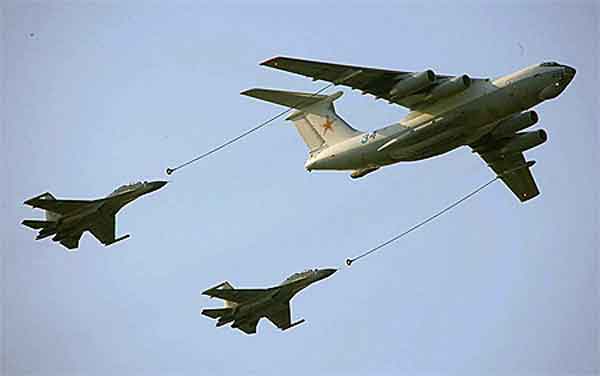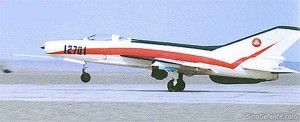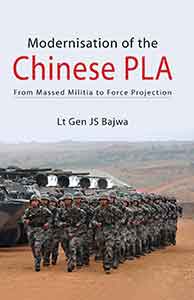The S-300 series of missiles meet long-range air-defense, anti-tactical ballistic missile, and anti-cruise missile requirements, (the Patriot is the only current equivalent).68 The Tor-M1 will also be able to intercept some PGMs. China is also likely to develop its own new generation of air defense systems with a combination of missiles and cannons. If the PLA were to acquire the new Russian S-400, it would have a 250 mile (400 km) range SAM that could dominate the Taiwan Straits without having to put it in vulnerable coastal bases.69
China has also developed the FT-2000 anti-radiation SAM. This SAM is based on the S-300 and is designed to engage radiating aircraft, such airborne jammers and AWACS aircraft and electronic fighter planes. China first tested the system in September 1998, and then conducted the first field trials during a series of exercises in 1999.70 At the same time, the PLA has been developing anti-missile systems. Richard D Fisher Jr. claims that Chinese officials at the 1998 Zhuhai Air show had mentioned that future active-guided versions of the FT-2000 missile would eventually have an anti-ballistic missile (ATMB) capability the control of these is not known, it could be either the PLAAF or the Second Artillery.
It is apparent that PLAAF will gradually build an indigenous aerial refuelling capability that could be supplemented by Russian tanker aircraft.
In terms of its radar technology, the Chinese have used variable frequency for their ground-to-air missiles and such missiles with a multi-guidance system as the FM-90 that have come into being. For low-altitude search capability, China plans to induct Israeli made early warning radar.71 Today, China’s missile program’s highlight is the PL-12/SD-10 Anti Aircraft Missile (AAM), its first active-radar AAM, one of the few such systems available anywhere in the world.72 China has reportedly acquired samples of Russian Kh-55 ‘Granat’ or ‘Tomahawk-s`ki’ air launched long range cruise missiles (LRCMs) from Ukraine for reverse engineering.73
Long Range Bombers. The PLA has also been reportedly negotiating for surplus Tupolev Tu-22M3 Backfire and Tu-95MS Bear strategic bomber aircrafts available with Russia. The Backfires are capable of carrying a variety of nuclear and conventional missiles and bombs including laser guided and other precision guided weapons including anti-ship and anti-aircraft carrier missiles. The Backfires reportedly have flown very little so far and their life could extend up to 2040.74 There are also unconfirmed reports of an H-9 bomber project that may involve some Russian technical assistance.
EW/ELINT and AWACS. The current modest effort of the Chinese to equip the PLAFF with EW/ELINT/AWACS belies a more intensive effort in this area. China has contracted for three, possibly six, A-50 Mainstay (based on IL-76 aircraft) Airborne Early Warning and Control (AEW&C) aircraft, with delivery commencing since 2005. A report by the International Assessment and Strategy Center indicates that the first three A-50s are being equipped with an indigenously built phased array radar system named “Balance Beam.”75 The Balance Beam radar is reported to have a resemblance in appearance to the Swedish Ericsson Erieye radar, which could give it a detection range of about 300-450 km.76 The deal with Israel to put the Phalcon 200 mile range airborne early warning radar on the IL-76 may have been stalled due to the US pressure on Israel. Israel was also contracted for electronic intelligence technology. In the last several years, four Tu-154M were modified to carry a very basic EW suite.
The use of civil aircraft is not new to the PLAAF. During the 1989 Tiananmen situation, civil aircraft were used to transport PLA troops to Beijing.
The second batch of 22xSu-27 imported from Russia were equipped with the Sorbitsya ECM pod. Evidence of a more extensive effort were revealed at the 1998 Zhuhai Air Show, when for the first time the Southwest China Research Institute of Electrical Equipment displayed its KG300G airborne jamming pod, its KZ900 ELINT pod, and its KZ800 ELINT system for larger aircraft — like the Tu-154. It was also informally revealed that an EW variant of the JH-7 strike fighter aircraft was in development. It is likely that this aircraft may be equipped with these pods that have been developed.77
Aerial Refuelling. It is apparent that PLAAF will gradually build an indigenous aerial refuelling capability that could be supplemented by Russian tanker aircraft. The H-6 bombers converted for aerial refuelling are now entering active service, initially to service J-8IID fighters. This could then also extend the range of the Su-30 strike fighters now being procured or in the future, Su-27 and JH-7s being modified for aerial refuelling. In September 2005, it was reported that PLA has successfully negotiated with Russia for purchase of eight IL-78MK aerial refuelling aircraft.78
Transport Forces. The use of civil aircraft is not new to the PLAAF. During the 1989 Tiananmen situation, civil aircraft were used to transport PLA troops to Beijing. Additional reports also maintain that the PLA used civil aircraft to ferry troops to Tibet during an exercise in 1999. For both intensive theatre and beyond theatre operations, the PLA will require a far more robust airborne transport force. It is unlikely that the PLA would remain satisfied with its small number of IL-76 and Xian Y-8 transports, albeit, augmented by a large fleet of civil jet transports in the airlines linked to the PLA. There have been occasional suggestions of PLA interest in the large AN-124. China may also be interested in greater cooperation with Ukraine’s Antonov Bureau, which has the modern AN-70 tactical transport. This transport can carry almost as much as an IL-76, as far as well.
Short Take Off & Landing (STOL) transport on its drawing boards appearing to be an advanced development of the Y-8 indicates impressive forward thinking on the part of the PLA. Such STOL transport would add much greater flexibility to airborne forces and give more options for Special Forces activities. It would also ease logistic support of South China Sea areas that could in future have small strips. Also significant is the purchase of the Russian Beriev Be-200 amphibious turbofan powered transport. With an impressive range and a 7.5 tonne/60 personnel lift capability, the Be-200 has the potential to transform PLA’s South China Sea outpost activity giving it more political options or imperatives in this region as it will enhance its ability to undertake greater economic activities in these disputed regions.79 In September 2005, it was reported that PLA has successfully negotiated with Russia for purchase of 30 IL-76MD transport aircraft.80
The IL-76 transport aircraft will reduce the deployment time of the 15th Airborne Army and is also intended to support a new formation, the 16th Airborne Army, while the IL-78 M will provide aerial refueling capability for Su-30MKK and other probe equipped combat aircraft. The IL-76 MD version is capable of lifting 47 tonnes of cargo or 190 fully equipped troops. The IL-78 will augment the existing rudimentary aerial refueling capability of the PLAAF based on a total of “10 obsolete Xian H-6Us (Tu-16), which are essentially H-6 bombers fitted with under wing hose and drogue pods.81
Rapid Reaction Force. The Airborne Troops of the 15th Airborne Army are designated as RRF. According to an October 1993 Jane’s Defense Weekly report, the Army initially had three brigades, which were converted to division size forces with an approximate total strength of 10,000 troops each. Airborne units are composed of eight types of troops: scouts, infantry, artillery, signals, engineers, anti-chemical warfare corps, and automobile corps. According to the PLAFF commander Liu, since the force began receiving Russian 10 x IL-76 transport aircraft in 1992, this force has acquired an all-terrain, all-weather, omni-directional combat capability.82
In order to adapt to various adverse operational conditions, the airborne units have conducted exercises in the snowfields of the Greater Khningan Mountains, the jungles on the Shiwan Mountains in Guangxi, and the Kunlun Plateau located 4,600 meters above sea level.83 Airborne troop training over the past few years appears to have focused primarily in and around Tibet. The PLA’s rapid-reaction strategy is based on the premise that China will only be engaged in local wars for the foreseeable future, and that the PLA must strike quickly to end the war and meet Beijing’s political objectives.84
Notes:
50 Ken Gause, op cit, p. 10.
51 Ibid. Also see Kaun Cho Chia, Military Regional Commanders Express Support for Jiang Zemin. Military works out development Plans for the 21st Century”, Kuang Chiao Ching, No-300, September 16, 1997.
52 Stockholm International Peace Research Institute (SIPRI) Yearbook 2005, pp. 422-425.
53 Ibid.
54 East Asian Strategic Review 2000, The National Institute for Defense Studies, Japan, p. 223.
55 “Aiming for the high ground,” Jane’s Defense Weekly, August 10, 2005, pp. 24-28.
56 Douglas Barrie and Jason Sherman, “China Seeks British Engine”.
57 Evan S Medeiros, et. al, A New Direction for China’s Defense Industry, Santa Monica, RAND Corporation, 2005, p. 423.
58 Ibid.
59 Min Zengfu and Han Jibing, “Air Defense Pattern of the 21st Century: Large-Area Dynamic Joint Air Defense”, Jiefangiun Bao, July 14, 1998.
60 Richard D Fisher Jr., “Questions About the Air Battle Dimension of the PLA’s Information Strike Combine,”www.ndu.edu/inss/China centre, p. 8.
61 Ibid.
62 Ibid.
63 Ibid.
64 Ibid., p. 11.
65 Dr. Srikanth Kondapally, “Chinese Air Force Towards 2015”, available at http://www.freerepublic. com/focus/news/761528/posts, last accessed on April 15, 2006; Dr Richard Fisher Jr., “PLAAF Equipment Trends” paper presented at National Defense University Conference on “PLA and Chinese Society in Transition”, published on October 30, 2001, available at http://www.strategycenter.net/ research/pubID.8/pub_detail.asp, accessed on February 14, 2006.
66 Ibid., p. 9.
67 Yihong Zhang in PLA Articles 4, “How Did the Persian Gulf War Affect the Chinese Army At www.kanwa.com/english/981230b.html.
68 Asian Military Review, March/April 2001, p. 22.
69 Ibid., p. 10.
70 Ibid., pp. 223-224.
71 Yihong Zhang, n. 67.
72 “Crouching Tiger: How China is quietly evolving its missile systems”, Jane’s International Defense Review, February, 2006, pp.28-31 and N-25, Richard Fisher, Jr.
73 “Top ten Chinese military modernization developments”, International Assessment and Strategy Center, March 25, 2005, p. 10, at http://www.strategycenter.net, last accessed on February 20, 2006; SIPRI Yearbook 2005 etc.
74 Dr Carlo Kopp, “Backfires and the PLAAF’s New Strategic Air Force”, International Assessment and Strategy Center, September 22, 2004, at http://www.strategycenter.net, last accessed on February 21, 2006.
75 Richard Fisher, Jr., “Chinese Dimensions of the 2005 Moscow Aerospace Show”, published on September 12, 2005.
76 “All China Special Missions Platform Makes Appearances”, Jane’s Defense Weekly, December 14, 2005, p. 7; “Special Mission Aircraft,” Chinese Defense Today, at http://www.sinodefense. com/airforce/specialaircraft, last accessed on February 15, 2006.
77 Ibid.
78 Robert Henson, “China boosts its air assets with Ilyushin aircraft”, Jane’s Defense Weekly, September 21, 2005, p. 16; Richard Fisher, Jr., “Chinese Dimensions of the 2005 Moscow Aerospace Show”, International Assessment and Strategy Center, September 12, 2005, at http://www.strategycenter.net, last accessed on March 13, 2006.
79 Ibid., p. 13.
80 Robert Henson, n. 78., p. 16 and Richard Fisher, Jr., n. 78.
81 Ibid.
82 Kenneth W Allen, “PLA Air Force Operations and Modernization”, in Susan M Puska, ed., Peoples Liberation Army After Next, p. 199. Also see Sun Maoquing, “Make Efforts to Build Modernized People’s Airforce – Interview with Air Force Commander Lieutenant General Liu Shunyao,” Beijing Liaowang, FBIS April 14,1997, No. 15, pp. 20-21.
83 Ibid.
84 Ibid., p. 200.








Living in France is one thing desired by many individuals. If you want to live in France then you have to get French property. You can read the advertisement section of the newspapers which has the section of houses for sale in France. After making a suitable choice, you should research about the properties for sale in France. French property is now a days very much wanted also.
If you want to live in France and spend your life there you should select a proper house. French property is not cheap and you need to make a major investment. You must also know about the properties for sale in France at various locations. The houses for sale in France come in different prices depending on the location
A very infomative & revealing article. Anyone who thinks that Russia is a ” TRUE & RELIABLE ” Friend of India should read his article..It is the Russians who are Upgrading & modernising the Chinese air Force in a Big way-With complete Transfer of Latest Technology.